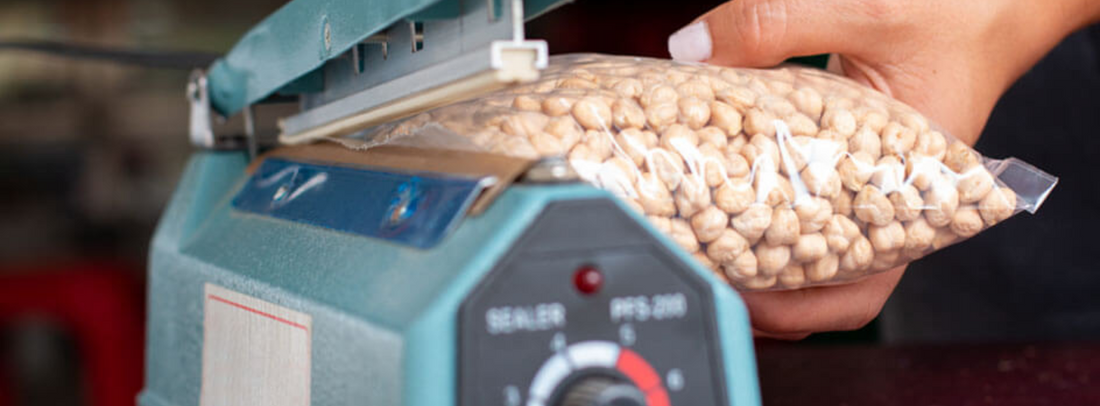Heat sealing is a way to join materials together using heat and pressure. The right material is important for this process to work. In today article, we will talk about what makes a material good for heat sealing. It will also cover different types of materials used for heat sealing. This information will help you choose the best materials for your packaging needs.
- A Comparative Analysis of Vacuum Sealers vs. Heat Sealers
- Heat Seal Bag and Pouche: All Essentials to Know About
- How to Heat Seal Poly Bags: Complete Guide
Factors Affecting Heat Sealability
The ability of a material to be heat sealed depends on several factors:
Material Properties
- Thickness: Thicker materials generally require higher temperatures and longer dwell times for effective sealing.
- Density: Denser materials may require higher temperatures and pressure to achieve adequate sealing.
- Melting Point: The material's melting point should be below the sealing temperature to allow for a molten state, which is necessary for forming a seal.
- Chemical Composition: Certain chemicals may interfere with the sealing process, affecting the seal's strength and integrity.
Sealing Temperature
- Temperature Range: The appropriate sealing temperature depends on the specific material being used.
- Heat Source: The type of heat source (e.g., electric, gas) can affect the temperature distribution and sealing quality.
Dwell Time
- Holding Time: The length of time the material is held at the sealing temperature is crucial for forming a strong bond.
- Temperature Distribution: Ensuring even heat distribution during the dwell time is important for consistent sealing.
Pressure Applied During Sealing
- Force: The amount of pressure applied to the material during sealing affects the seal's strength and integrity.
- Distribution: Even pressure distribution is essential for a uniform seal.
- Pressure Type: The type of pressure (e.g., mechanical, pneumatic) can influence the sealing process.
Types of Heat Sealable Materials
This section will provide an overview of the different types of materials that can be used for heat sealing. It will also discuss the advantages and disadvantages of each type of material.
Thermoplastics
Thermoplastics are materials that soften when heated and harden when cooled. They are commonly used for heat sealing due to their flexibility and ease of processing.
- Polyethylene (PE): A versatile plastic with excellent heat sealability, available in various densities (LDPE, HDPE, etc.).
- Polypropylene (PP): Offers good heat sealability, especially when used with tie layers or additives.
- Polystyrene (PS): Can be heat sealed, but may require additives or special treatments for optimal results.
- Polyvinyl Chloride (PVC): Heat sealable, but may require plasticizers or additives to improve flexibility.
- Nylon: A strong and durable material with good heat sealability, often used for packaging food and medical products.
- PET: A clear and strong plastic with good heat sealability, widely used for food and beverage packaging.

Thermosetting Plastics
Thermosetting plastics are materials that undergo a chemical reaction when heated, forming a rigid, non-reversible structure. They are generally not as suitable for heat sealing as thermoplastics due to their limited flexibility.
- Phenolics: Used for some packaging applications but may have limited heat sealability.
- Epoxies: Primarily used for adhesives and coatings, with limited heat-sealing applications.
- Melamines: Commonly used for tableware and decorative items, with limited heat-sealing potential.
Foils
Foils are thin sheets of metal that can be heat sealed. They are often used in combination with other materials to create laminated structures.
- Aluminum Foil: A common material for heat sealing, offering excellent barrier properties against moisture, oxygen, and light.
- Copper Foil: Less commonly used for heat sealing but can be used in specific applications.

Laminates
Laminates are materials formed by combining different layers of materials, often using heat and pressure. They can offer a wide range of properties, including heat sealability, barrier properties, and mechanical strength.
- Paper/Foil Laminates: Commonly used for food packaging, combining the barrier properties of foil with the printability of paper.
- Film/Foil Laminates: Offer excellent barrier properties and can be heat sealed to create pouches and other packaging structures.
The choice of heat sealable material depends on factors such as the product being packaged, the desired properties (e.g., barrier properties, mechanical strength), and the specific heat sealing method to be used.
Heat Sealing Methods
This section will discuss the various methods used for heat sealing packaging materials.
Impulse Sealer
This is a hand-held device that uses heat and pressure to seal small bags and pouches.
- Advantages: Portable, easy to use, suitable for low-volume production.
- Disadvantages: Limited sealing capacity, may not be suitable for large or irregularly shaped items.
Continuous Band Sealer
This method use a machine with a continuous sealing band that can seal a wide range of materials at high speeds.
- Advantages: High production capacity, suitable for large-scale sealing operations.
- Disadvantages: Requires more space and maintenance than an impulse sealer.
Rotary Sealer
This is the way of using a machine with a rotating sealing head that can seal containers with complex shapes and sizes.
- Advantages: Versatile, capable of handling a variety of packaging formats.
- Disadvantages: More complex to operate and maintain than other sealing methods.
Ultrasonic Sealing
This methode use a non-contact sealing method that uses high-frequency sound waves to create a seal.
- Advantages: Suitable for delicate materials, no need for heat or pressure, can produce hermetic seals.
- Disadvantages: Can be more expensive than traditional sealing methods, may require specialized equipment.
.Conclusion
Heat sealing is a versatile and efficient method for joining materials together. The choice of packaging material and sealing method depends on various factors, including the desired properties, production volume, and cost considerations. By understanding the different types of heat sealable materials and their characteristics, as well as the available heat sealing methods, you can select the most appropriate options for your specific packaging needs.




